*This post may contain affiliate links. Read more »
Avakaya Pachadi, is known in India as the "King of Pickles,” and also aam ka achar. Crafting this delectable condiment requires nothing more than a little patience, and a good eye for picking out the best mangoes for pickling. The mangoes should be firm, imparting a delightful balance between sweetness and tartness. The mangoes are then cut, delicately spiced with an array of aromatic ingredients, and matured to become the most intense condiment. You will straight up just want to eat it over aged basmati pilau!


Enter your email & I'll send it to your inbox. Plus, get great new recipes from me every week!
By submitting this form, you consent to receive emails from Cinnamon Snail.
Avakaya Pachadi gets its name from the combination of two Telugu words: "Avakaya" meaning mango, and "Pachadi" referring to a pickle or chutney. This iconic condiment has been cherished for generations, and its distinctive tangy flavor and fiery undertones have become a staple in Andhra households.
Mangoes are the pride of Andhra Pradesh, the southern coastal region of India. The unique combination of the region's fertile soil and abundant sunshine gives birth to mangoes with exceptional taste and aroma. And these marvelous mangoes form the heart and soul of Avakaya Pachadi.
What sets Avakaya Pachadi apart is its incredible versatility. It can elevate a simple meal of biryani and dal tadka to a whole new level, blowing yer' durn mind with its explosive combination of flavors. Spread it on warm kulcha, savor it with crispy bhaji, or even use it as a condiment for chaats like Shakarkandi.
Grab your ingredients and whip up this seriously flavorful mango pickle. Relish the ritual of pickling, and delight in the warmth of Andhra's culinary heritage.
Jump to:
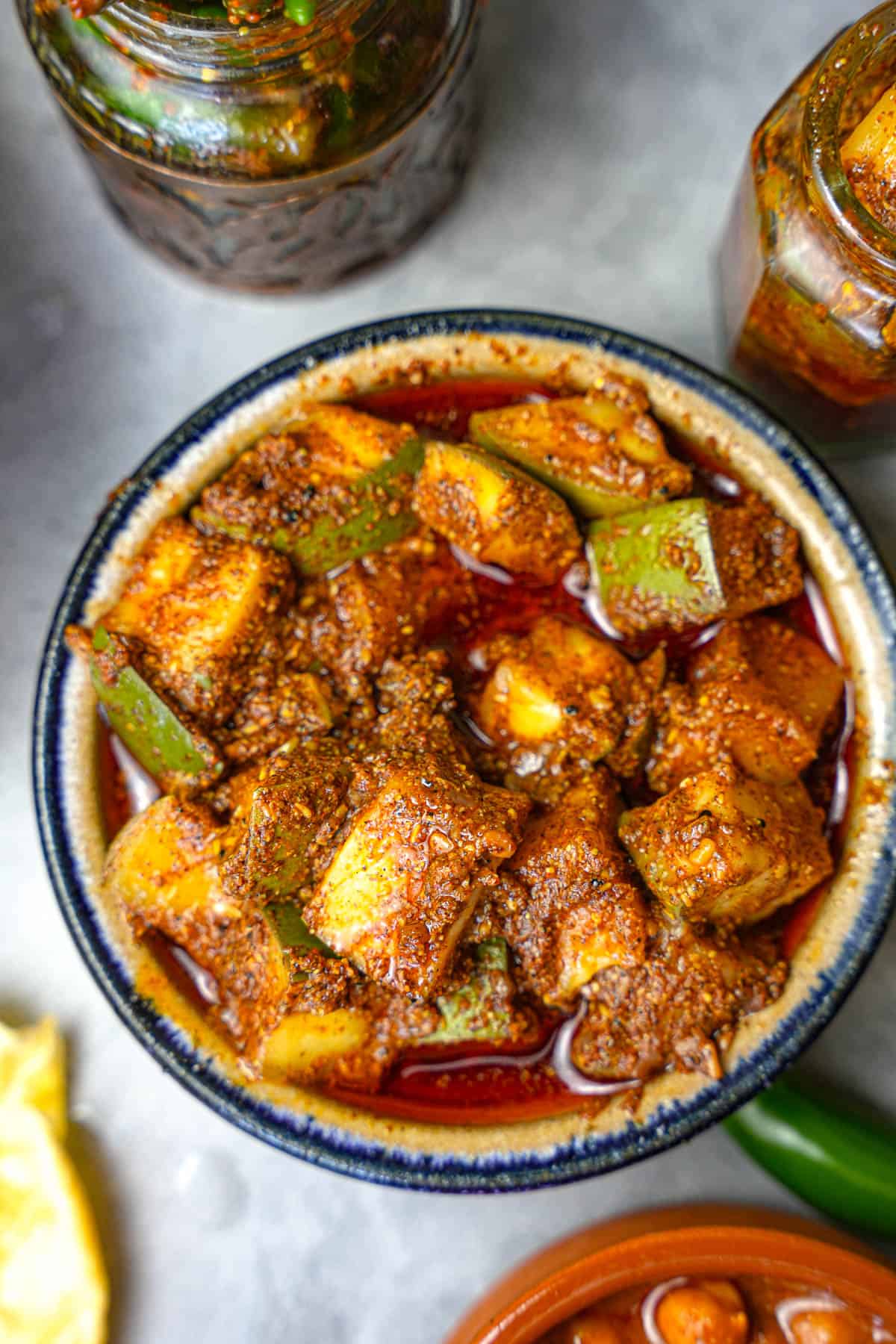
🥭What is mango pickle?
If you are a Westerner used to dill-pickled cucumbers, mango pickle is gonna push you off a cliff head first into intense flavors that you weren’t expecting.
This delectable pickle is made using green mangoes, (AKA raw mangoes), which are sliced, spiced, and preserved to create a tangy, salty, spicy, and umami rich accompaniment. Each region in India brings its own unique twist to mango pickle, infusing it with a blend of aromatic spices, creating a tantalizing explosion of flavors. In some regions, people simply mix the diced mango with achar ka masala and oil and let it ferment in the sun.
Mango pickle, known by various names in India, such as Aam Ka Achaar in Hindi, Maangai Oorugai in Tamil, Avakai or Avakaya in Telugu, Mavadu or Vadu Mangai throughout South India, and Keri Ka Achaar in Gujarat and Rajasthan is a cherished condiment that epitomizes the vibrant culinary landscape of India. Andhra mango pickle is generally sattvic, but you can add sliced garlic cloves if that's your thing.


🥒 Learn to make amazing pickles and ferments
This guide to my most popular pickle recipes is 100% FREE, & you'll love the actual heck out of it 🥰
🥰Why you'll adore this Andhra mango pickle recipe
✊Vegan, Gluten-Free AND Sattvic! Avakaya Pachadi contains no animal-based ingredients, gluten, onions, or garlic. Long story short, this makes the condiment perfect for everyone, including as bhoga for the Supreme!
💣An Absolute Flavor Bomb: Mango pickle elevates anything you put it on. (Ok, maybe not pound cake). Be it a humble bowl of coconut rice and masoor dal, or a lavish Indian feast, a dollop of Avakaya Pachadi takes the meal’s flavor to the next level.
✅Tested and Approved Worldwide: Like all of the vegan Indian recipes I share, this pickled mango recipe has been tried, tested, and loved by over 500 recipe testers who volunteer with me from all around the world!
🥭 Mango pickle ingredients

Mango
Green mango, also known as unripe, or raw mango, refers to mangoes that are tangy and firm in texture. It is a key ingredient in Avakaya Pachadi. You can also use green mango to make banh trang tron and ensaladang talong. Green mangoes are a rich source of Vitamin C and fiber. In this recipe, the green mango provides a refreshing tartness and crispness, balancing the flavors and adding a distinct tangy note. If green mangoes are unavailable, you can use unripe mangoes or tart fruits like fresh alma (amlaki), or crisp green apples as a substitute.
Mustard Oil
Mustard oil (“Aava Nune" ఆవ నూనె in Telegu) is a pungent cooking oil with natural preservative properties, making it ideal for Indian pickles. It contains heart-healthy fats, antioxidants, and vitamin E. Make sure to use refined mustard oil, as it is healthier for you and better for pickling than cold-pressed mustard oil. Its distinctive flavor and aroma lend a unique character to the pickle.
If you don't have mustard oil available or prefer a milder taste, you can substitute it with a neutral-flavored oil like sunflower or vegetable oil. Some people use gingelly oil (sesame oil), but I prefer it made with an oil that doesn't obscure the flavor of the tart mango as much.
Fenugreek
Fenugreek seeds, also known as methi seeds, are small, bitter seeds with a slightly nutty flavor. If you don't have fenugreek seeds, you can use a pinch of fenugreek powder as a substitute. The fenugreek here will be ground anyway to create the spice mix for the pickles.
Kashmiri Red Chili
Kashmiri red chili powder is known for its vibrant red color and mild to moderate heat. It is commonly used in Indian cuisine to impart a beautiful red hue to dishes without overwhelming spiciness (like you want to do when you make sukha kala chana). If you can't find Kashmiri red chili powder, you can use a combination of paprika and cayenne pepper to achieve a similar flavor and color, adjusting the heat level to your preference.
*See the recipe card at the bottom of the page for exact quantities, nutritional info, and detailed cooking directions.
📖 How to make this avakai pickle recipe
You wanna see how this yummy thing gets made? I will walk you through the whole process. Or you can follow along with the easy-to-print recipe card towards the bottom of this page.

Step 1
Cut the green mango, with or without the skin into 2 cm. cubes. Discard the seeds.
Step 2
Evenly sprinkle the salt over the raw mango cubes in a mixing bowl. Give it a thorough mix, ensuring you coat each mango piece. Let the mixture sit for about 30 minutes. This step lets the salt draw out excess moisture from the mangoes, resulting in a better texture for the pickle.
Step 3
After 30 minutes, squeeze any excess moisture from the mango cubes into a colander. Transfer the mangoes to a clean, dry bowl. This step helps remove any residual water and ensures that the pickle stays fresh longer.
✅ Do not rinse the mangoes, as you want to keep them salty as a preservative.
Step 4
In a small skillet, toast the fenugreek, mustard, and optional nigella seeds over low heat. Stir continuously until they turn a slight golden color and release a delightful nutty aroma. Allow them to cool down completely.
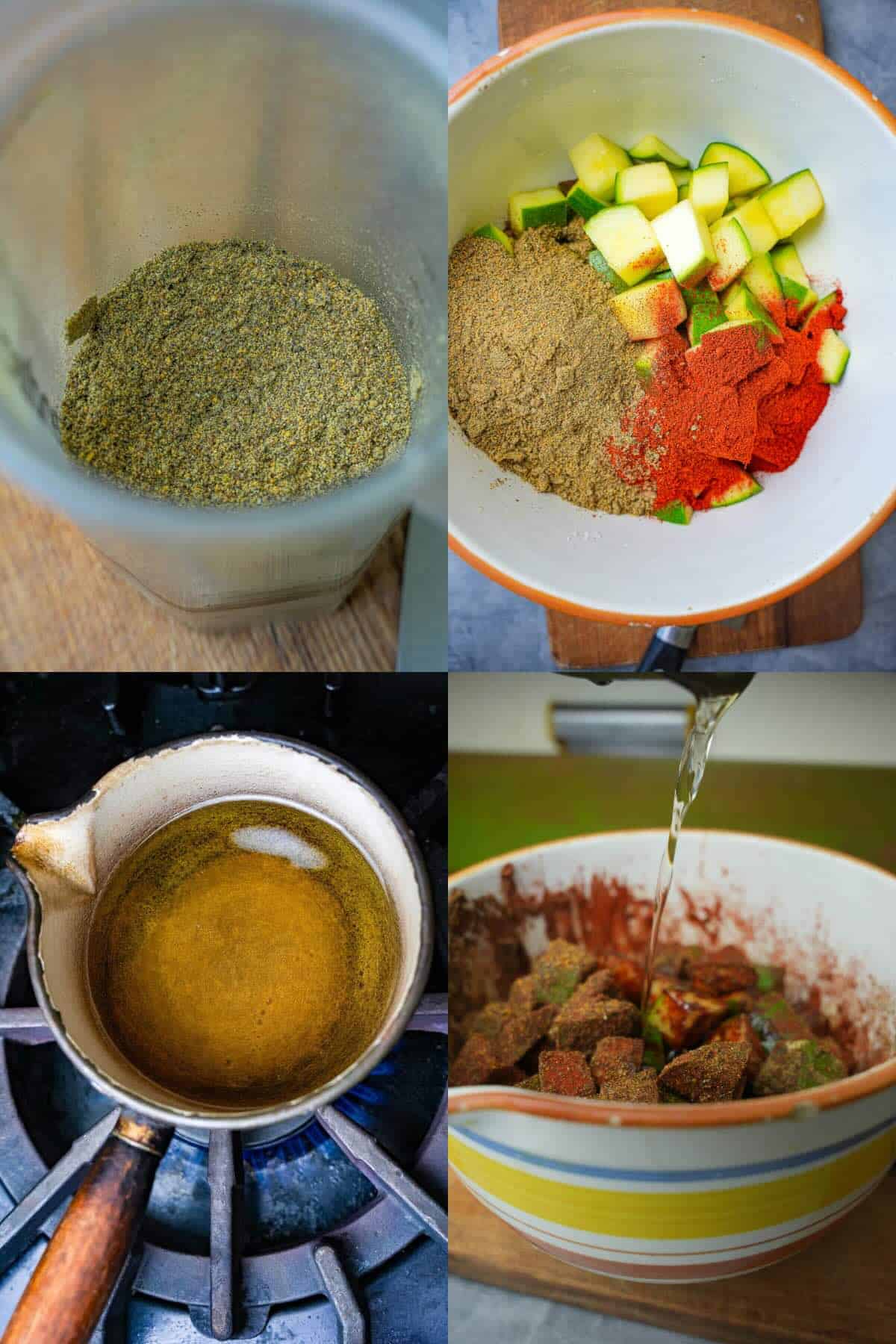
Step 5
Once cooled, grind the toasted seeds into a fine powder using a spice grinder, blender, or a mortar and pestle. This step helps release the aromatic oils, intensifying the flavors when incorporated into the pickle.
✅ Do not rinse the mangoes, as you want to keep them salty as a preservative.
Step 6
Stir the Kashmiri chili powder and ground fenugreek, nigella, and mustard powder into the mango cubes. Mix thoroughly, ensuring the spices distribute throughout the pickle.
👉Kashmiri red chili powder adds vibrant color and flavor to the pickle without overwhelming heat. If you prefer a spicier pickle, you can add a pinch of cayenne pepper, add sliced hari mirch, or adjust the amount of red chili powder accordingly.
Step 7
In a small pan, heat the mustard oil or peanut oil over medium heat for a couple of minutes until it reaches a near-smoking point. Turn off the heat and let the oil cool down for about 20 minutes to reach room temperature.
Step 8
Pour the oil over the mango mixture, ensuring it coats well all the ingredients.
✅Mustard oil imparts a unique flavor to the pickle. If you find its taste too strong, you can substitute it with peanut oil for a milder flavor.
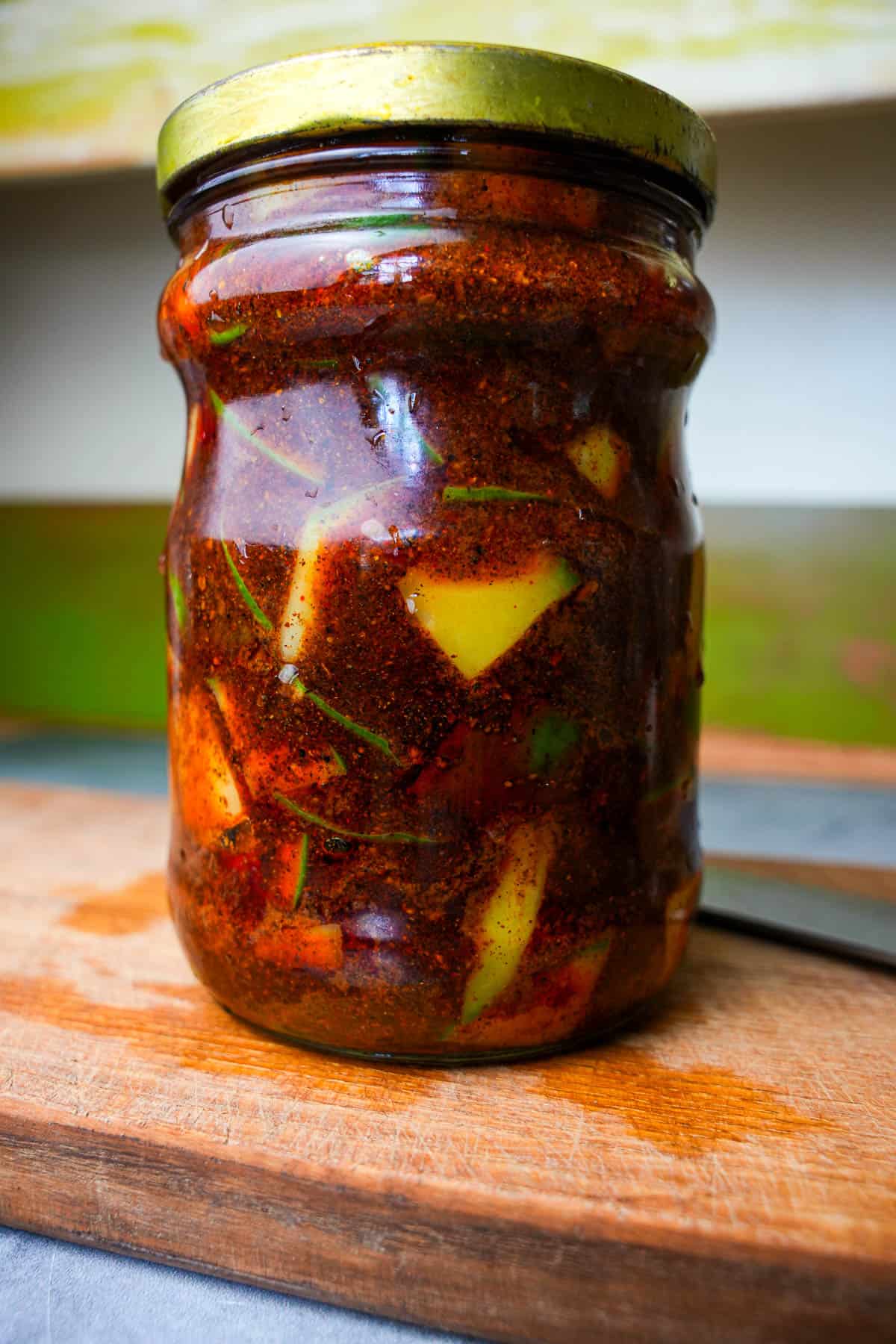
Step 9
Transfer the aam ka achar to a clean, sterilized glass jar or an airtight container. Press down gently to remove any air bubbles and ensure the pickle is completely submerged in oil. This helps preserve the pickle.
Close the jar tightly and let the pickle mature for 24-48 hours at room temperature, preferably in direct sunlight. This fermentation process allows the flavors to intensify, and the mango to soften resulting in a more complex and delicious pickle.

Step 10
Once the pickle has fermented at room temperature, you can store it in the refrigerator for up to two months. The flavors will continue to develop, providing a delightful accompaniment to your meals.
When using the mango pickle, be sure to use clean, dry metal spoons while serving to avoid any moisture or bacteria entering the jar.
🍽️Serving Ideas
Mango pickle makes everything better. Here are some suggested dishes to have it with:
Serve a generous spoonful of Avakaya Pachadi alongside a comforting bowl of chana dal over aromatic coconut rice.
Create a flavor explosion by combining the rich and creamy vegan butter chicken (made with my from-scratch homemade seitan) with flavorful parwal sabji. Top it off with a dollop of Avakaya Pachadi, which cuts through the richness of the seitan-based butter chicken.
Add a vibrant touch to your chaat spread by serving mango pickle alongside masala phool makhana, or medhu vadai
Upgrade the flavors of your favorite subzis with a spoonful of Avakaya Pachadi. Whether it's the creamy aviyal, Kerala-style olan, arbi sabji, the comforting lauki sabji, ridge gourd kootu, aromatic saag aloo, or Punjabi bhindi, the pickle adds a tangy and spicy twist, taking your sabjis to the next level.
Complete your vegan Indian feast with fluffy and flaky Kerala parotta, msemen, or freshly grilled homemade pita bread.

👉Top tips for making mango pickle safely
To sterilize glass jars for pickling, follow these simple steps:
- Wash the glass jars and lids thoroughly with hot, soapy water to remove any dirt or debris. Thoroughly rinse off the soap with hot water.
- Fill a large pot with enough water to completely submerge the jars. Place the pot on the stove over medium-high heat. Place a plate, screen or small cake pan at the bottom of the pot to prevent the jars from coming in direct contact with the bottom of the pot, which can cause them to break.
- Once the water reaches a rolling boil, carefully place the jars and lids in the pot, ensuring they are fully submerged.
- Allow the jars to boil for about 10 minutes to ensure proper sterilization. This process kills any bacteria or microorganisms present.
- Using tongs, carefully remove the sterilized jars and lids from the pot and place them on a clean, dry cooling rack to dry.
- Let the jars and lids air dry completely. Avoid touching the inside of the jars or lids with your hands or unsterilized utensils to maintain cleanliness.
🤷♀️Recipe FAQs
The consumption of mustard oil has declined in recent years due to concerns over erucic acid content, which is naturally present in high amounts in traditional cold-pressed mustard oil. However, commercially available mustard oil in India now undergoes a refining process that reduces erucic acid levels, making it safer for consumption.
Please note that aam ka achar does not freeze well due to its texture and the presence of oil. Consuming and enjoying the pickle within its recommended storage time frame is best.
Store under refrigeration for a month or longer. Make sure to cover the mango pieces in oil, and always use a clean, dry metal spoon when serving the pickle so it stays good for longer.
Mango pickles are made by combining raw mangoes with a punchy mix of spices like turmeric powder, asafoetida, chili powder, mustard seeds, and salt. To kickstart the flavor and preservation, many traditional instructions also call for vinegar or lemon juice. Once you mix everything together, you let the pickle sit to develop that bold, briny tang we all crave.
Pro tip: use organic mangoes when you can. They hold their texture better during the making pickle process.
Mango pickles are the spicy condiment of dreams. Expect a wild combo of sour, salty, spicy, and just slightly bitter from the skin of the mangoes. You’ll get earthy notes from the turmeric powder and a deep umami kick from asafoetida. Depending on how you make it, the heat level can range from a whisper to a full slap. Either way, that layered taste is what makes it such an iconic part of Indian cuisine.
Use mango pickles to bring an explosion of flavor to anything needing a boost. They’re the ultimate side to dal, rice, roti, and even vegan yogurt bowls. You can add a spoon to wraps, sandwiches, or stir it into chutneys for next-level tang. Some folks even blend it into marinades or dressings. Basically, anywhere a fiery, tangy spicy condiment would do good work.
A mango pickle can turn black if exposed to too much air, sunlight, or moisture while it’s still fermenting. Oxidation or using wet spoons during serving can mess with its vibe. Sometimes it’s just the natural aging process of the spices and vinegar reacting with the mangoes and oil, especially if you used a lot of turmeric powder or didn’t store it properly. It’s usually still safe, but always check for off smells or mold before diving in.
✌️My faves to serve with mango pickle:
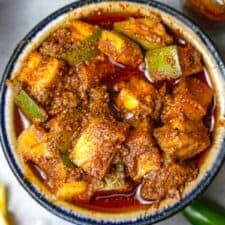
Avakaya Pachadi (Andhra Mango Pickle)
Equipment
Ingredients
- 3 medium size green mango 2.2 lb/1 kg, cut into 1-inch/2.5cm cubes (about 5 cups when cut)
- 2 tablespoons salt
- ¼ cup Kashmiri Red chili powder
- ¼ cup mustard seeds
- 2 tablespoons fenugreek seeds
- 1 tablespoon kalonji seeds optional1 ¼ cup mustard oil or peanut oil
- 1 ¼ cup mustard oil or peanut oil, or vegetable oil
Instructions
- In a large mixing bowl, add the raw mango cubes and sprinkle the salt over them. Mix well and set aside for about 30 minutes. This helps to extract moisture from the mangoes and enhances the pickle's texture.
- In a small skillet, toast the fenugreek, mustard seeds, and optional nigella seeds over low heat until they turn slightly golden and emit a nutty aroma. Allow them to cool, then grind them into a fine powder using a spice grinder or mortar and pestle.
- After 30 minutes, squeeze out any excess moisture from the mango cubes gently in a colander. Transfer the mangoes to a clean, dry bowl.
- Add the Kashmiri red chili powder and ground seeds to the mango pieces and mix thoroughly, ensuring that each piece is well coated with the spice. Adjust the amount of chili powder according to your preferred level of spiciness.
- Heat mustard oil or peanut oil in a small pan over medium heat for a couple of minutes until it almost reaches a smoking point. Turn off the heat and allow the oil to cool for 20 minutes to room temperature. Pour the oil over the mango mixture, ensuring all ingredients are well-coated. Stir the pickle thoroughly to combine all the flavors and spices.
- Transfer the Avakaya Pachadi to a clean, sterilized glass jar or airtight container. Press the pickle down with a clean, dry metal spoon to release as many air bubbles as possible. Make sure there is at least 1 cm of space at the top of the jar to allow for expansion.
- Close the jar tightly and let the pickle mature in direct sunlight for at least 2-3 days at room temperature.
- After fermenting at room temperature, the pickle can be stored under refrigeration for up to two months.
Notes

Enter your email & I'll send it to your inbox. Plus, get great new recipes from me every week!
By submitting this form, you consent to receive emails from Cinnamon Snail.

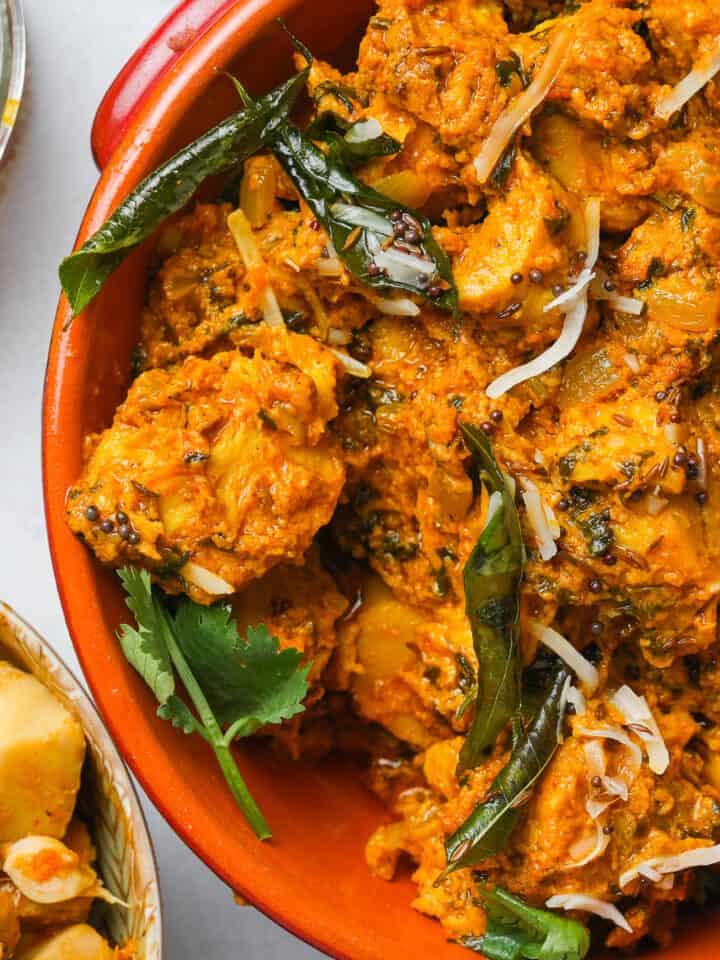


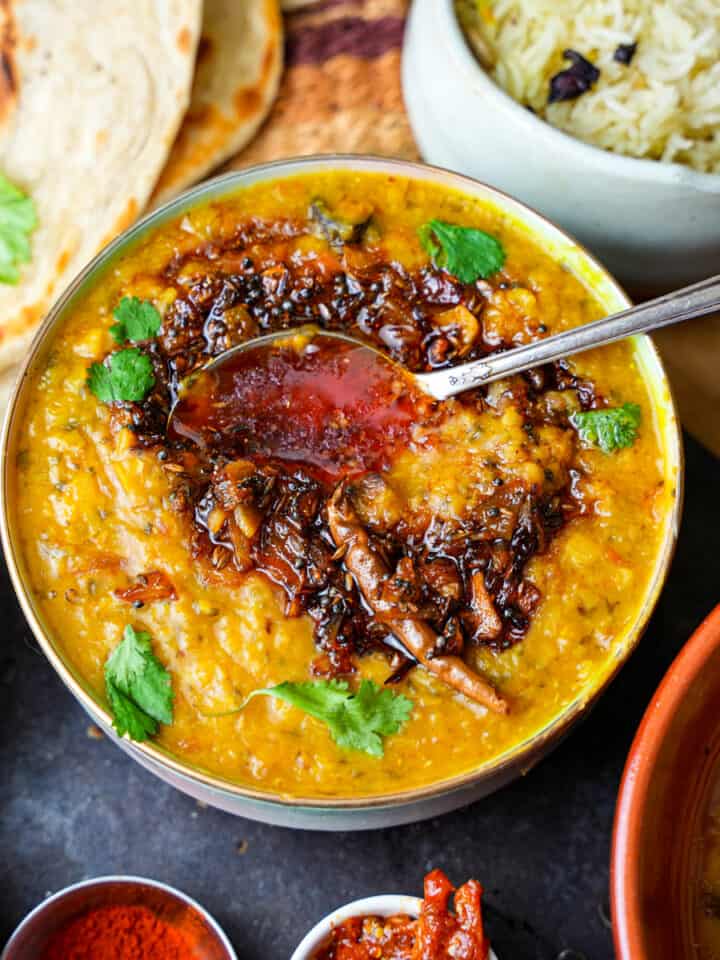



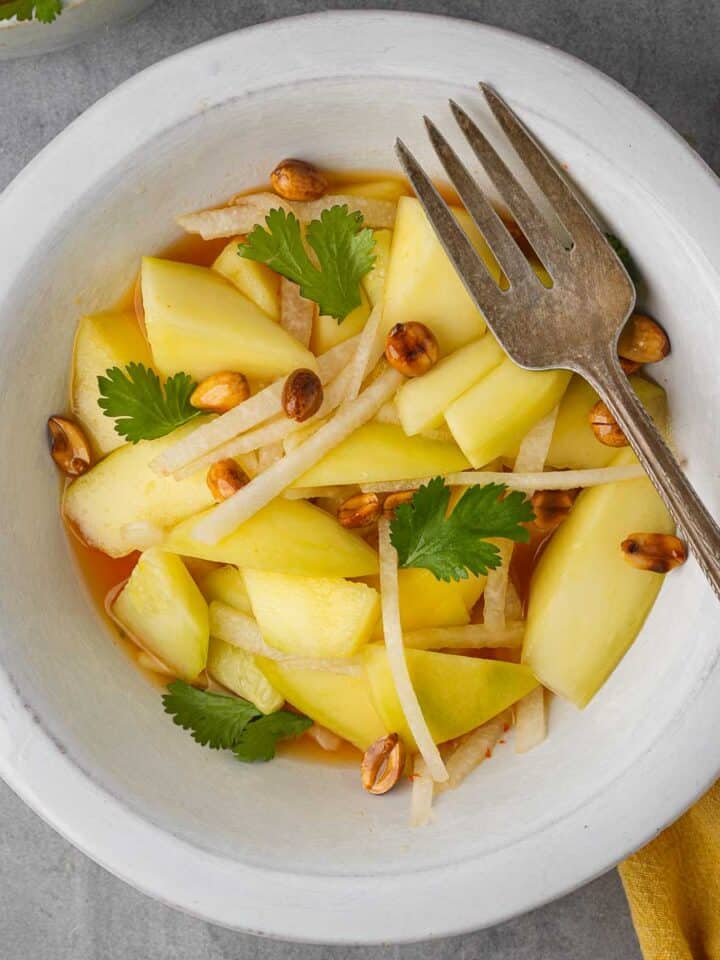
D says
As usual, authentic taste we’ve all come to expect from Adam. His recipes are the vegan bomb!